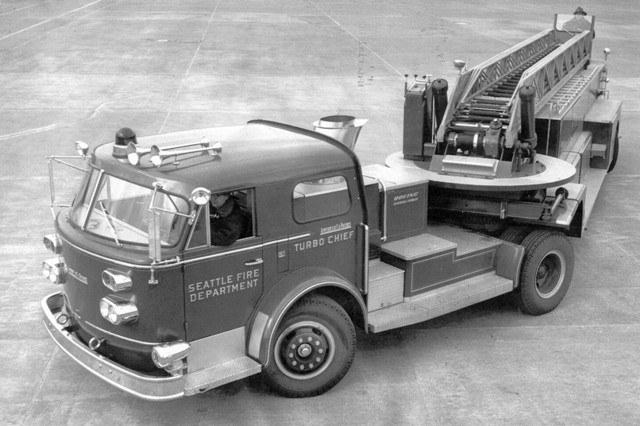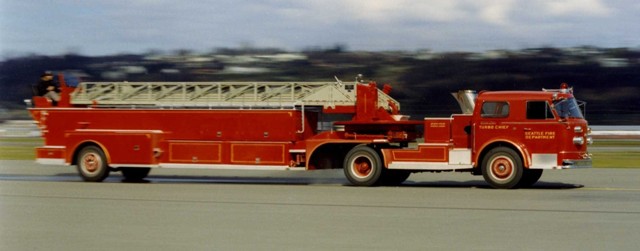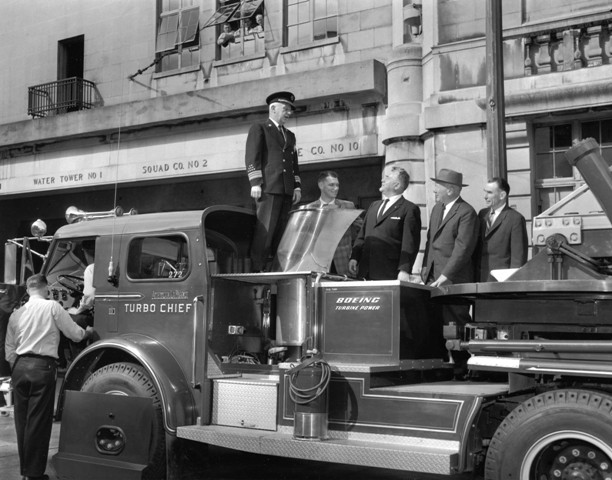During late 1950s and into the early 1960s the world was turbine crazy and as propellors gave way to fans, the companies building the compact and powerful engines were looking for all sorts of applications to put their machines to work on. If they could fly ever larger planes, ever increasing distances what else could they do? Boeing was really a leader in this field and their turbines found their way into all different kids of stuff like big rigs and at least once, a fire truck. Called the Turbo Chief the machine was more than just an experiment, it was an important and active part of the Seattle Fire Department’s equipment from very early in 1961 until very late in 1962 and the reason the truck was then modified had nothing to do with the powertrain.
The failures of turbines in stuff like over the road trucks were not power derived but economy derived. The things just absolutely drank fuel while doing their work. This was a major problem for people pulling loads over the mountains or across the country but it was not so much a concern when a truck would be operating within the relatively compact confines of a city. Such was the case when Boeing and the Seattle Fire Department got together and teamed up on the Turbo Chief, a 1960 American LaFrance 900 series tractor that had a 100ft tall ariel ladder on its back. Rather than the standard huge displacement gasoline or smaller displacement diesel engine, this one had a Boeing 502-10MA turbine engine that was rated for 324hp. This thing was likely the fastest fire truck of its type the country with this engine. The turbine itself weighed just over 300lbs and there were no gas or diesel options out there that produced near the power that this little guy did. The truck would run to 50mph in just over 30 seconds and that was some kind of feat.
The city paid a little more than $52,000 for the big red hot rod and the only thing that set it apart from other trucks visually was the huge exhaust stack located behind the cab. As most of you know, depending on how the fuel system is setup, the turbine engines can run on virtually anything that is combustable. Gasoline, diesel fuel, kerosene, or jet fuel. The rig weighed 30,000lbs.
In something that may strike you as counter intuitive, the turbine power pack was actually LESS complex than the diesel or gasser that it replaced. There was no cooling system for starters. Less electrical, less linkage for various operations, and overall it seemed as though maintenance would be low and that was one of the potential selling points of the setup. Unfortunately it would be maintenance that caused the end for the Turbo Chief.
In what may have been the last smart decision made by a municipal employee in charge of a contract in America, it was written in the deal that if the city did not like the turbine engine they could have it replaced with a conventional power plant for no cost to them. Boeing would pick up the ticket. The problem with the truck was pretty simple. Seattle has a lot of hills, the turbine engine has a lot less compression braking power than a gasoline engine or a diesel engine with an exhaust brake on it so the 30,000lb truck gobbled up brakes like Skittles.
It was constantly in the shop for brake maintenance and every time that happened it was not living up to the $50,000 the city spent on it so in late 1962 it went to the American LaFrance facility and had a big Hall-Scott engine and manual Fuller transmission. Those two elements cured the braking issues although we’re sure the guys that drove it liked the other setup more, unless they were terrified at the lack of braking on hills when they were trying to boogie to a call. As a bit of an epilogue, the Hall-Scott powered the truck until 1977 when a Detroit Diesel and an Allison automatic transmission were installed. If you can believe it, the truck worked for the city in that configuration until 1991 and then it was retired.
That may have been the best $52,000 a city in the USA ever spent. Nearly 30 years on the job with three different power plants. That’s longevity for sure. And now you know the story of the Turbo Chief.
AUTHOR’S NOTE: I AM SINCERELY SORRY THAT I DO NOT HAVE THE NAME OF THE BANGSHIFTER THAT TIPPED ME OFF TO THIS TRUCK. CONTACT ME: [email protected]
Click on the link below to the photos to see more history and images of the Turbo Chief
















This wasn’t the only “turbo chief” experimental out there. San Francisco had a 900 series convertible engine that had a jet turbine as well. It would light awnings on fire from the amount of heat it put off. So this isn’t “The” story of the turbo chief.
https://www.flickr.com/photos/munidave/847353944
I bought this truck at auction from the City of Seattle and have owned it ever since. Over the ensuing years I have acquired a Boeing model 502-10MA gas turbine engine identical to the one originally installed in the truck with the aim of returning the truck to turbine power. I have had many first-person interviews with the Boeing Turbine Division engineers that were involved with the truck and wish to relay their assessment of what actually led to the end of the Seattle fire Department’s use of the gas turbine. It was NOT brake wear or that the hot exhaust started fires (pure bull!) It was the fact that, unlike the turbine installation on the San Francisco pumper in which the brakes air compressor was belt driven directly off the power section of the gas turbine, the air compressor on the Seattle truck was driven off the manual road transmission. In actual fire service use, which is usually of runs of a few blocks in length, the air compressor did not supply sufficient air to keep the brakes readily operable. Rather than opt for having the truck out of service to wait for re-engineering of the air compressor drive system, the City elected to exercise its option to have the entire prime moving system replace with a conventional Continental gasoline motor. As one retired Boeing engineer said to me last week, “It was not the gas turbine’s fault, the fault was ours.”